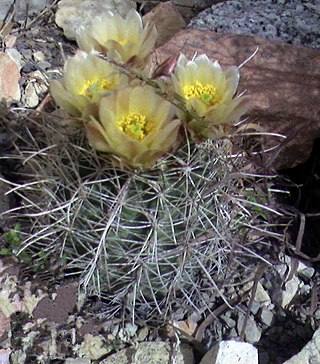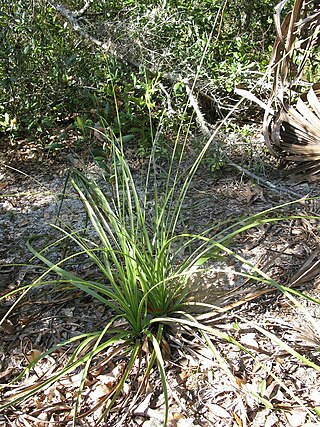
A cactus is a member of the plant family Cactaceae, a family comprising about 127 genera with some 1,750 known species of the order Caryophyllales. The word cactus derives, through Latin, from the Ancient Greek word κάκτος (káktos), a name originally used by Theophrastus for a spiny plant whose identity is now not certain. Cacti occur in a wide range of shapes and sizes. They are native to the Americas, ranging from Patagonia in the south to parts of western Canada in the north, with the exception of Rhipsalis baccifera, which is also found in Africa and Sri Lanka. Cacti are adapted to live in very dry environments, including the Atacama Desert, one of the driest places on Earth. Because of this, cacti show many adaptations to conserve water. For example, almost all cacti are succulents, meaning they have thickened, fleshy parts adapted to store water. Unlike many other succulents, the stem is the only part of most cacti where this vital process takes place. Most species of cacti have lost true leaves, retaining only spines, which are highly modified leaves. As well as defending against herbivores, spines help prevent water loss by reducing air flow close to the cactus and providing some shade. In the absence of true leaves, cacti's enlarged stems carry out photosynthesis.

Sclerocactus is a genus of cacti. It comprises about 15 species, the exact number depending on the authority. These species are very xerophytic. They are sometimes called 'fishhook cactus' or 'little barrels.'

The strawberry hedgehog cactus or Engelmann's hedgehog cactus is commonly found in desert areas of the southwestern United States and the adjacent areas of Mexico, including the states of California, Nevada, Utah, Arizona, Baja California and Sonora.

Taxus floridana, the Florida yew, is a species of yew, endemic to a small area of under 10 km² on the eastern side of the Apalachicola River in mesophytic forests of northern Florida at altitudes of 15–40 m. It is listed as critically endangered. It is protected in reserves at the Torreya State Park and at the Nature Conservancy's Apalachicola Bluffs and Ravines Preserve, and has legal protection under the United States and Florida Endangered Species laws.

Echinocereus reichenbachii is a perennial plant and shrub in the cactus family. The species is native to the Chihuahuan Desert and parts of northern Mexico and the southern United States, where they grow at elevations up to 1,500 meters (4,900 ft). This cactus earned the Royal Horticultural Society's Award of Garden Merit.

Opuntia humifusa, commonly known as the devil's-tongue, Eastern prickly pear or Indian fig, is a cactus of the genus Opuntia present in parts of the eastern United States, Mississippi and northeastern Mexico.

Acanthocereus tetragonus is a species of cactus that is native to Florida and the Lower Rio Grande Valley of Texas in the United States, Mexico, Central America, the Caribbean, and northern South America. The species is invasive in New Caledonia. Common names include night-blooming cereus, barbed-wire cactus, sword-pear, dildo cactus, triangle cactus, and Órgano-alado de pitaya (Spanish). The miniature cultivar is known as fairy castle cactus. It was originally described by Carl Linnaeus in 1753 as Cactus tetragonus but was moved to the genus Acanthocereus in 1938 by Pieter Wagenaar Hummelinck.

Harrisia fragrans is a rare species of cactus known by the common name fragrant prickly apple. It is endemic to Florida, where it is known only from St. Lucie County. The plant's habitat has been almost completely consumed by development, leading to its rarity. It is a federally listed endangered species of the United States.

Escobaria sneedii is a rare species of cactus known by the common names Sneed's pincushion cactus and carpet foxtail cactus. It is native to the Chihuahuan Desert, where it occurs in scattered locations in New Mexico, Texas, and Chihuahua. Some plants occurring in Arizona may be included within this species. Botanical authors do not necessarily agree on the circumscription of this species. Most will agree at this point in the research, however, that there are two varieties of Escobaria sneedii, and that both are rare and endangered. The plant is popular with cactus enthusiasts and dealers because of its often petite size and tolerance for moderately cold climates. They have been overharvested from their natural habitat, the main reason why the two varieties, var. sneedii and var. leei, have been federally listed as endangered and threatened, respectively.

Echinocereus viridiflorus is a species of cactus known by the common names nylon hedgehog cactus, green pitaya, and small-flowered hedgehog cactus. It is native to the central and south-central United States and northern Mexico, where it can be found in varied habitat types, including desert scrub, woodlands, dry grasslands, and short-grass prairie.

Nolina brittoniana is a rare species of flowering plant in the asparagus family known by the common name Britton's beargrass. It is endemic to Florida, where there are 72 known populations, only a few of which are large enough to be considered viable. It is federally listed as an endangered species of the United States.

Pediocactus bradyi is a very rare species of cactus known by the common names Brady's pincushion cactus, Brady's hedgehog cactus, and Marble Canyon cactus. It is endemic to Arizona in the USA, where it is restricted to Marble Canyon in Coconino County, though its exact distribution is not generally advertised due to poaching concerns. It is limited to a specific type of soil, it has a small distribution, and the species is threatened by a number of human activities. This has been a federally listed endangered species of the United States since 1979.

Pediocactus despainii is a rare species of cactus known by the common names Despain's cactus and San Rafael cactus. It is endemic to the state of Utah in the United States, where it is limited to the San Rafael Swell in Emery County, Utah.

Pediocactus knowltonii is a rare species of cactus known by the common names Knowlton's miniature cactus, Knowlton's pincushion cactus, and Knowlton's minute cactus.

Sclerocactus brevispinus is a rare species of cactus known by the common name Pariette cactus. It is endemic to Utah in the United States, where it is known only from the Pariette Draw, a draw in Duchesne County. It is threatened by a number of processes and human activities.

Sclerocactus wetlandicus is a rare species of cactus known by the common name Uinta Basin hookless cactus. It is endemic to Utah in the United States, where it is known only from the Uinta Basin. It may also be called the Pariette cactus, but this name is more appropriate for Sclerocactus brevispinus, the species endemic to the Pariette Draw of Duchesne County.

Consolea corallicola is a species of cactus known by the common names Florida semaphore cactus and semaphore pricklypear. It is endemic to Florida in the United States, where it is limited to the Florida Keys.

Echinocereus dasyacanthus is a member of the cactus family, Cactaceae. It is one of about 2000 total species belonging to this family. The cactus is commonly known as Texas rainbow cactus because of the subtle rings or bands of contrasting colors along the stem of the plant. Not all Texas rainbow cacti have the "rainbow" coloration on their stems. Another common name is spiny hedgehog cactus.

Cochemiea thornberi is a species of cactus known by the common names Thornber's fishhook cactus and Thornber's nipple cactus. It is native to Arizona in the United States and Sonora in Mexico.
Peniocereus striatus is a species of cactus known by several common names, including gearstem cactus, cardoncillo, jacamatraca, sacamatraca, and dahlia-rooted cactus. It is endemic to the Sonoran Desert, where it occurs in Baja California, Sinaloa, and Sonora in Mexico and Arizona in the United States.




















